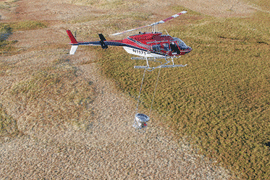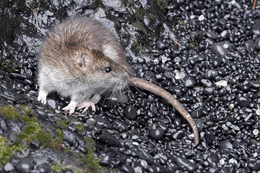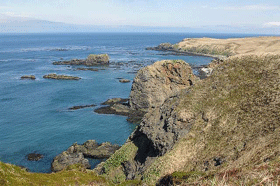Taking the “Rat” out of Rat Island
Air Date: Week of July 17, 2009

A helicopter flings rat bait over Alaska’s Rat Island. (Photo: Aleutian Fox)
Alaska’s Rat Island may need a new name. Thanks to a two year, two and a half million dollar eradication project, the island’s signature, but invasive, rodent resident has finally been given the boot. Steve MacLean, Polar Marine Program Director for the Nature Conservancy, tells Steve Curwood about one of the world’s largest island rat eradication efforts.
Transcript
YOUNG: Rat Island off of Alaska might need a new name. A two-year, two and a half million dollar e-rat-ication project gave the island’s signature rodent the boot. The federal government teamed with private groups like the Nature Conservancy for the largest rat removal in U.S. history.
Steve MacLean, Polar Marine Program Director for the Nature Conservancy, told Living on Earth’s Steve Curwood how the rats got there in the first place.
MACLEAN: Well Rat Island is an island out in the Aleutian Islands, about 1300 miles from Anchorage. In about 1780 a fishing boat went aground on the rocky shores. It was a small boat, a small number of rats, but 230 years later the rats had really run over the entire island and decimated the seabird populations that existed there.

This brown rat, Rattus norvegicus, is the target of succesful eradication efforts on Rat Island. (Photo: Aleutian Fox)
CURWOOD: So how do you go out fixing a problem of this size?
MACLEAN: Well we spread out bait containing a rodenticide around the island using helicopters with specially designed and manufactured buckets underneath, like agricultural fertilizer buckets that would spread the bait in a pattern around the island and then allow every rat the opportunity to consume a lethal dose.
CURWOOD: Rats are pretty wily. They wouldn’t eat something that was obviously poisonous.
MACLEAN: Yeah, that’s one of the considerations that we had to think about in that they are neophobic, so they’re very curious and careful about new things in their environment. So this is a second-generation rodenticide, which means that it’s a delayed acting toxin, so about four or five days after the rats consume the bait is when they start to feel sick. Once that happens, typically they go into their burrows and the vast majority of the rats actually die in their burrows, underground.
CURWOOD: So this rat poison that you spread, why wouldn’t the birds eat this?
MACLEAN: The bait was specially designed so that it would not be attractive to birds that might be on the island. It’s large enough that song, sparrows and other small birds wouldn’t be able to eat it whole. Its also colored blue which is a color that is shown not to be attractive to a lot of these birds. And then seabirds are fish eaters and so eating at sea, and so normally would not be picking up things off of the ground to consume.
CURWOOD: But all this poison on the ground, couldn’t it just leach into the soil there and be around for a good while?
MACLEAN: Well the toxin itself is bound very tightly to the grain, and so once the moisture gets into the grain pellet and breaks it down, the toxin becomes unavailable to other organisms. And also after the microbes get ahold, the toxin itself breaks down to carbon dioxide and water, so there are no nasty chemicals that are left behind.
CURWOOD: I’m thinking though about raptors. Eagles are petty lazy hunters, they would rather pick up something that’s already dead and make a meal than work for it. With these rats dying, if most of them went into their burrows, still there was some out there. What kind of raptor or bird kill did you have?MACLEAN: We did find a number of glaucous-winged gull carcasses and some bald eagle carcasses that we didn’t expect.
CURWOOD: How many dead eagles? How many dead gulls?
MACLEAN: We found I believe it was about 180 gulls and 41 eagles.
CURWOOD: It’s a good thing they’re not endangered in Alaska, huh?
MACLEAN: Yes, it really is. Again, that was much higher than we expected to find. The Aleutian Islands has got a population of about 2500 bald eagles. And so we’re confident that this mortality event will not have a lasting population level effect. However, we are very concerned about this level or mortality and are doing everything we can to understand what might have caused the deaths and then how potentially they can be avoided in the future.
CURWOOD: What are you seeing in terms of the recovery of the island ecosystem now that it is at least apparently rat free?
MACLEAN: We’re starting to see the first signs of birds returning to the island. So we’ve got peregrine falcons that are nesting on the island, black oyster catchers which are nesting on the island, but have never been seen before.
CURWOOD: So, well, let’s face it – rats are really pretty tough. They’re feisty, they’re hardy little suckers. [laugh] I mean they cause plagues. I mean when can you be sure that they’re truly gone from the island?
MACLEAN: We’ve set up a series of trap lines across the island using snap traps that you might find in a hardware store, but also wax chew blocks, which is a wax that has been made with peanut butter to actually make it attractive to the rats. And we’ve set those out in grids across the island, and we’ll come back next spring and check to see if the bite marks on the wax would indicate that rats are still present. So what we hope to find is these wax blocks with no chew marks on them whatsoever.CURWOOD: And of course your paraffin chew blocks will rat on any rats that are left.
MACLEAN: Exactly, yeah, there’s the telltale sign that we hope not to find.
CURWOOD: So the rats are gone and therefore the name of the island is gone. What are you going to name it?
MACLEAN: We would love nothing better than to return the Aleut name Hawadax to the island.
CURWOOD: Hawadax, which means…?
MACLEAN: Which means entry or welcome.
CURWOOD: Steve MacLean is the polar marine program directory for the Nature Conservancy. Thank you so much, sir.
MACLEAN: Thank you for having me. It’s been my pleasure.
[MUSIC: Various Artists/Another Fine Day “In 5 from Six Degrees Of The Middle East (Six Degrees Records 2009)]
YOUNG: Just ahead – the cost of being clueless. What we don’t know really is hurting us. Stay with us - on Living on Earth.
YOUNG: It’s Living on Earth, I’m Jeff Young.
Living on Earth wants to hear from you!
Living on Earth
62 Calef Highway, Suite 212
Lee, NH 03861
Telephone: 617-287-4121
E-mail: comments@loe.org
Newsletter [Click here]
Donate to Living on Earth!
Living on Earth is an independent media program and relies entirely on contributions from listeners and institutions supporting public service. Please donate now to preserve an independent environmental voice.
NewsletterLiving on Earth offers a weekly delivery of the show's rundown to your mailbox. Sign up for our newsletter today!
 Sailors For The Sea: Be the change you want to sea.
Sailors For The Sea: Be the change you want to sea.
 The Grantham Foundation for the Protection of the Environment: Committed to protecting and improving the health of the global environment.
The Grantham Foundation for the Protection of the Environment: Committed to protecting and improving the health of the global environment.
 Contribute to Living on Earth and receive, as our gift to you, an archival print of one of Mark Seth Lender's extraordinary wildlife photographs. Follow the link to see Mark's current collection of photographs.
Contribute to Living on Earth and receive, as our gift to you, an archival print of one of Mark Seth Lender's extraordinary wildlife photographs. Follow the link to see Mark's current collection of photographs.
 Buy a signed copy of Mark Seth Lender's book Smeagull the Seagull & support Living on Earth
Buy a signed copy of Mark Seth Lender's book Smeagull the Seagull & support Living on Earth


